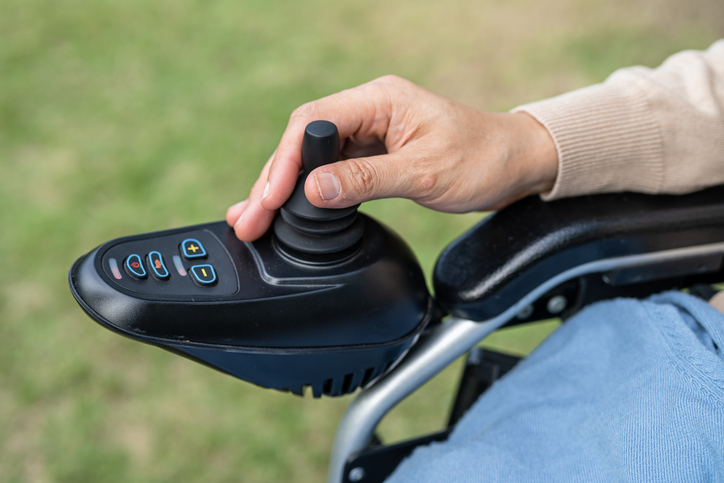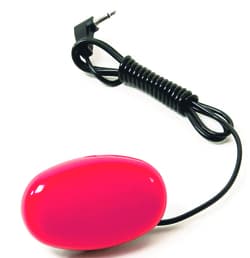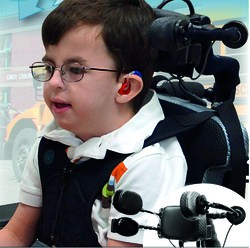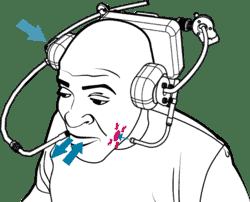Categories
Speciality Areas
Alternative controls to a standard joystick

The convention for driving a powered wheelchair is to have a joystick positioned at the end of an arm support by which means the occupant can drive and steer their electric wheelchair. However, not everyone has the facility or the control to manipulate a joystick. So what alternatives are there?
In the Getting Power Under Control piece in this series, we looked at the choices available for positioning a driving control joystick in order to facilitate better control of the joystick, apart from the somewhat conventional position of placement at the end of the arm support.
In this article we look at alternatives to a joystick for those who cannot use an off-the-shelf joystick to drive their powerchair – for example, by the use of switches linked in through relevant software.
With the application of a little bit of ingenuity to the choice and positioning of the available alternatives, anyone should be able to operate an electric wheelchair and its accessories, and manage their environment.
Positioning
Often it is the experience and lateral thinking of the assessor that is needed to find the best solution to meet the client’s need. At the more simple level: If someone cannot use their hands, can they use their elbows? If someone cannot use their hands or arms, can they use their knees or toes?
For a person who is a paraplegic, and has no lower body control, what can be done with the head – e.g. operate a mini-joystick operated by the chin (Figure 1), switches at the side of the head that need the smallest of neck movement, sip-and-puff switches operated from the mouth, sensors picking up eye movement. Where there’s movement, there’s a possibility.

Figure 1. A centrally mounted chin-operated joystick
Switches
In addition to the joystick, electric wheelchairs already have a number of switches to manage other functions on the wheelchair, the simplest of which is the on/off switch. Switches come in several functional guises: it is this choice that allows for an appropriate selection according to specified needs. For some users who cannot manipulate a joystick, multiple switches may be the best or only solution.
Latching switches
Latching switches are those which switch from one mode to another, e.g. from on to off, and vice versa. Some of these, such as a light switch, have a very obvious position between the two (although in the US, on is in the opposite direction from what we are accustomed to in Europe).
Others toggle the activity from status A to status B, but return to the original physical position. A good example is an ‘egg switch’ (Figure 2) where touching any part of the surface toggles the switch. These are ideal for operation by head, elbow, knee, etc movements.

Figure 2. Egg switch
There are variations of specialist switches. One example is the use of a light beam that is carried through a fibre optic cable. A small movement of, say, a finger, to block the beam, can be transmitted to the electronic switching controls. The amount of light that gets reflected back means that these can be used as proximity switches as well (see below). These take very little space, and could be mounted in a mini-tray, for example.
Eye-blink switches are another option, which can be linked to controls to give latched or timed (say, 1 to 120 seconds), or momentary (see below) output. The internal circuitry can be set to activate with each eye blink, or with every double eye blink, to ignore normal eye blinking.
Momentary switches
Momentary switches are those which only provide a ‘signal’ while they are being pressed, and then return to their off (or on) position. A door buzzer is an example of such a switch. In wheelchairs, using an array of momentary switches, one momentary switch could be used to drive a wheelchair forward, a second switch to veer left, a third switch to veer right, a fourth for reverse, etc.
For those with limited movement elsewhere in the body, sip and puff switches may be the solution. Sip and puff devices are switches that are managed by a lung inhalation or exhalation resulting in movement of air up or down a tube. These can be calibrated for four separate activities, a hard or soft sip, and a hard or soft puff.
A typical set-up to drive a wheelchair might be: an initial hard puff to enable the wheelchair to move forward, while a hard sip will stop the wheelchair. Conversely, an initial hard sip will enable the wheelchair to move backward, while a hard puff will stop the wheelchair (these are latched switch activities).
A continuous soft sip or soft puff will enable the wheelchair to move left or right respectively, depending on how long the user blows into the tube, straw, or ‘wand’ – these would be momentary switch activities. (A sip and puff device could also be used to perform computer mouse activities.).
Proximity switches
The disadvantages of the types of switch described above is a binary I/O driving activity for the wheelchair. It’s either forward or back, left or right, moving or not, all of which provides for jerky and unrefined movement. The use of proximity switches with appropriate software can overcome this challenge.
Proximity switches can come with different technologies (see box): the signal through them can be modulated by how close to the switch the part of the body being used to activate it is – the closer to the switch, the larger the signal e.g. to make the wheelchair go faster. If you add to this software that takes the signal from both a left-turning and a right-turning switch, small adjustment of the positioning between the two switches can achieve the net direction and speed of travel required.
An ideal set-up could be in a head array (although an array on a tray or on the foot support might suit the client better), where a pair of left and right proximity switches control the direction of travel, and a proximity switch behind the head controls the speed (and with a double movement toggle between forward/backward/stop).
An egg switch could be placed as an on/off switch, and/ or to switch modes to alternative programmes available from the wheelchair. Stealth Products was one of the pioneers for producing software with the iDrive (Figure 3) to integrate the signals, at high speed, from different proximity switches: the result is a system that is very intuitive to use.
Proximity switch technologies
- Capacitive: Suitable for sensing of short distances (up to 35 mm) and responds to all materials – thus very suitable for applications covered in this article
- Inductive: Range up 60 mm, but respond best if there’s ferrous material in the object controlling it, so not as suitable as a capacitive sensor
- Optic: Range up to 30 mm provided the object is not translucent, can be as good as a capacitive sensor for applications covered in this article
- Magnetic: Range up to 80 mm, but the object has to be made of magnetic material, so not ideal for our purposes
- Ultrasound: Designed for larger spaces (up to 1000 mm), vibration sensitive, and high cost, so not suitable for our purposes

Figure 3. The iDrive head array system
The iDrive is also supported by their Loonz gaming software package to train the potential user to use head arrays to good effect.

Figure 4. Head array combinations with ‘sip and puff’ for forward and reverse, fibre optic for mode change/reset and proximity sensors for left and right turns
Conclusion
There are so many options out there, combined with modern software, that it should be possible for most wheelchair users to manage their environmental controls, their computer, and their mobility, provided that they have some movement somewhere. All that’s needed is a little lateral thinking from the provider.